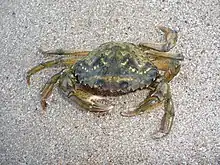Carcinus aestuarii
Carcinus aestuarii, also known as the Mediterranean green crab is a littoral crab, native to the Mediterranean Sea.
| Carcinus aestuarii | |
|---|---|
 | |
| Scientific classification | |
| Domain: | Eukaryota |
| Kingdom: | Animalia |
| Phylum: | Arthropoda |
| Class: | Malacostraca |
| Order: | Decapoda |
| Suborder: | Pleocyemata |
| Infraorder: | Brachyura |
| Family: | Carcinidae |
| Genus: | Carcinus |
| Species: | C. aestuarii |
| Binomial name | |
| Carcinus aestuarii | |
| Synonyms | |
| |
Carcinus aestuarii bears some similarities to Carcinus maenas and was sometimes considered to be a subspecies thereof, rather than a species in its own right, but a molecular biological study using the COI gene found the difference between the two taxa to be substantial, supporting their status as separate species.[2] The two taxa can be visually distinguished by the front of the carapace, between the eyes, which is short and toothed in C. aestuarii but longer and smoother in C. maenas. Also, the gonopods of C. aestuarii are straight and parallel, whereas those of C. maenas are curved.[3]
Distribution
It is found in the Atlantic Ocean around the Canary Islands, all along the coasts of the Mediterranean and the Black and the Azov Seas including the Suez Canal.[4]
Diet
C. aestuarii is an omnivorous predator of small bivalves with soft shells, small crustaceans, annelids as well as being a scavenger of dead aquatic animals. Algae is also part of the diet. Eating habits can change throughout its lifespan and seasonally in relation with available food in its habitat.[6][7]
References
- Peter K. L. Ng; Danièle Guinot; Peter J. F. Davie (2008). "Systema Brachyurorum: Part I. An annotated checklist of extant Brachyuran crabs of the world" (PDF). Raffles Bulletin of Zoology. 17: 1–286. Archived from the original (PDF) on 2011-06-06.
- Roman, Joe; Palumbi, Stephen R. (2004). "A global invader at home: population structure of the green crab, Carcinus maenas, in Europe" (PDF). Molecular Ecology. 13 (10): 2891–2898. doi:10.1111/j.1365-294X.2004.02255.x. PMID 15367106. Archived from the original (PDF) on 2017-08-13. Retrieved 2020-07-13.
- S. B. Yamada; L. Hauck (2001). "Field identification of the European green crab species: Carcinus maenas and Carcinus aestuarii" (PDF). Journal of Shellfish Research. 20 (3): 905–909. Archived from the original (PDF) on 2007-09-27.
- Števčić, Z; Galil, B (1993). "Checklist of the Mediterranean brachyuran crabs". Acta Adriat. 34: 5–76.
- James T. Carlton; Andrew N. Cohen (2003). "Episodic global dispersal in shallow water marine organisms: the case history of the European shore crabs Carcinus maenas and C. aestuarii". Journal of Biogeography. 30 (12): 1809–1820. doi:10.1111/j.1365-2699.2003.00962.x.
- Chen, R.B; Watanabe, S; Yokota, M (2004). "Feeding habits of an exotic species, the Mediterranean green crab Carcinus aestuarii, in Tokyo Bay". Fisheries Science. 70: 430–435.
- Baklouti, S; Derbali, A; Dhieb, K; Kammoun, W; Jarboui, O (2013). "Proximate composition and its seasonality of the Mediterranean green crab: Carcinus aestuarii Nardo, 1847 (Brachyura, Portunidae), in southern Tunisian waters (Central Mediterranean)". Journal of Marine Biology. 2013b: 1–6.